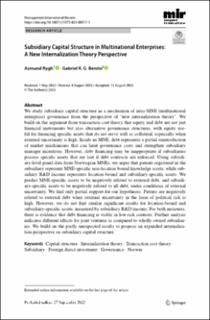Subsidiary Capital Structure in Multinational Enterprises: A New Internalization Theory Perspective
Journal article, Peer reviewed
Published version
Permanent lenke
https://hdl.handle.net/11250/3123201Utgivelsesdato
2023Metadata
Vis full innførselSamlinger
Originalversjon
MIR. Management International Review: journal of international business. 2023, 1-41. 10.1007/s11575-023-00517-1Sammendrag
We study subsidiary capital structure as a mechanism of intra-MNE (multinational enterprise) governance from the perspective of “new internalization theory”. We build on the argument from transaction cost theory that equity and debt are not just financial instruments but also alternative governance structures, with equity useful for financing specific assets that do not serve well as collateral, especially when external uncertainty is high. Inside an MNE, debt represents a partial reintroduction of market mechanisms that can limit governance costs and strengthen subsidiary manager incentives. However, debt financing may be inappropriate if subsidiaries possess specific assets that are lost if debt contracts are enforced. Using subsidiary-level panel data from Norwegian MNEs, we argue that patents registered in the subsidiary represent MNE-specific non-location bound knowledge assets, while subsidiary R&D income represents location-bound and subsidiary-specific assets. We predict MNE-specific assets to be negatively related to external debt, and subsidiary-specific assets to be negatively related to all debt, under conditions of external uncertainty. We find only partial support for our hypotheses. Patents are negatively related to external debt when external uncertainty in the form of political risk is high. However, we do not find similar significant results for location-bound and subsidiary-specific assets, measured by subsidiary R&D income. For both measures, there is evidence that debt financing is viable in low-risk contexts. Further analysis indicates different effects for joint ventures as compared to wholly owned subsidiaries. We build on the partly unexpected results to propose an expanded internalization perspective on subsidiary capital structure

